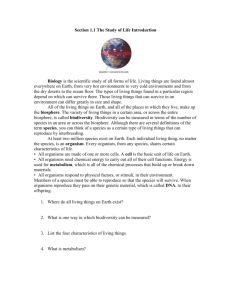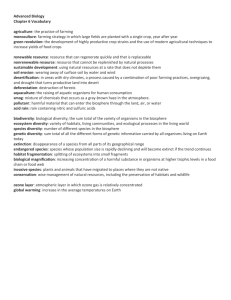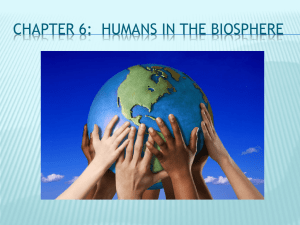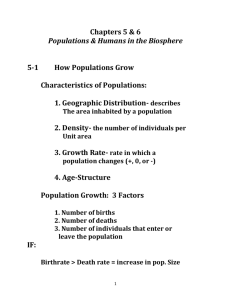Human Affect on the Environment and Wise Uses of Our Resources
advertisement
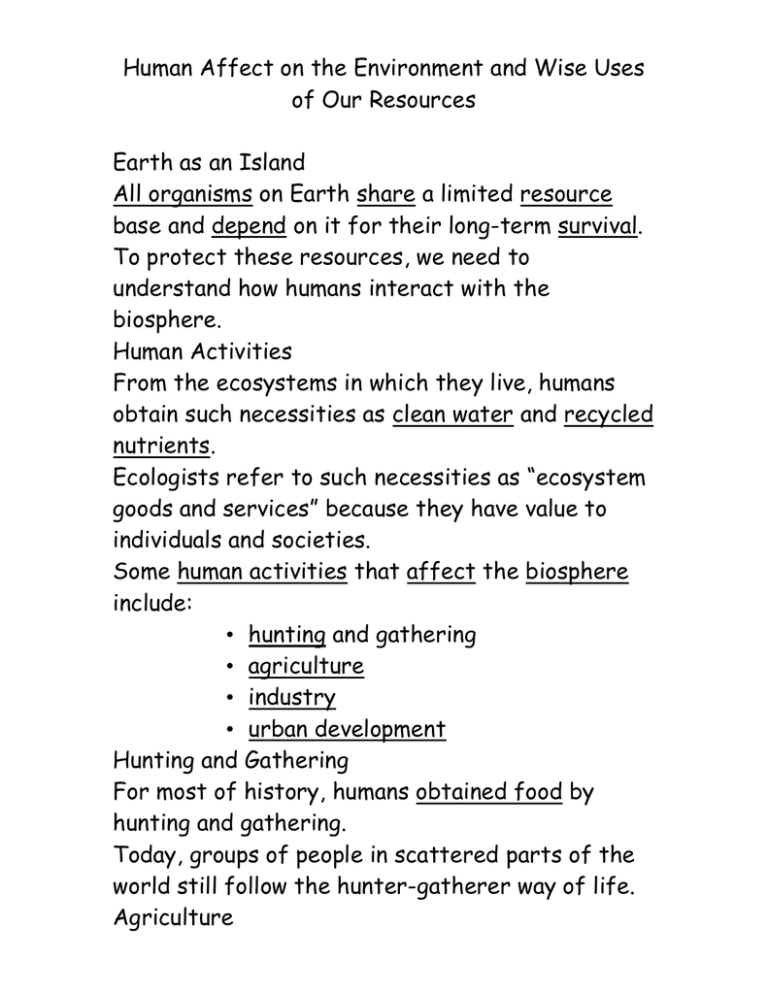
Human Affect on the Environment and Wise Uses of Our Resources Earth as an Island All organisms on Earth share a limited resource base and depend on it for their long-term survival. To protect these resources, we need to understand how humans interact with the biosphere. Human Activities From the ecosystems in which they live, humans obtain such necessities as clean water and recycled nutrients. Ecologists refer to such necessities as “ecosystem goods and services” because they have value to individuals and societies. Some human activities that affect the biosphere include: • hunting and gathering • agriculture • industry • urban development Hunting and Gathering For most of history, humans obtained food by hunting and gathering. Today, groups of people in scattered parts of the world still follow the hunter-gatherer way of life. Agriculture Agriculture is the practice of farming. It includes the production of crops and the raising of livestock. Agriculture provides human societies with a dependable supply of food that can be produced in large quantity and stored for later use. From Traditional to Modern Agriculture In the 1800s and 1900s, advances in science and technology set the stage for a remarkable change in agriculture. • Large-scale irrigation turned deserts into fertile farmlands. • New machinery helped farmers increase yields. • New varieties of crops produced higher yields. • Chemical fertilizers boosted plant growth. • Pesticides controlled crop-damaging insects. New crops were often grown using a practice called monoculture, in which large fields are planted with a single variety of crop year after year. The Green Revolution The green revolution was an effort in the midtwentieth century to increase global food production through modern plant breeding and agricultural techniques. Over the last 50 years, the green revolution has helped world food production double. Challenges for the Future While increasing world food supplies, modern agriculture has created ecological challenges. For example: • Monoculture leads to problems with insect pests and diseases. • Finding enough water for irrigation is difficult. Industrial Growth and Urban Development Human society and its impact on the biosphere were transformed by the Industrial Revolution, which added machines and factories to civilization. The energy to power machinery comes mostly from fossil fuels—coal, oil, and natural gas. Industrial growth and urban development affect both the local and global environment. Discarded industrial waste pollutes air, water, and soil. Dense human communities also produce waste. Suburban growth consumes farmland and stresses native plants and animals. How are environmental resources classified? Environmental goods and services may be classified as either renewable or nonrenewable. Renewable resources can regenerate if they are alive, or can be replenished by biochemical cycles if they are nonliving. A tree is an example of a renewable resource because a new tree can be planted in place of an old tree that dies or is cut down. A nonrenewable resource is one that cannot be replenished by natural processes. Fossil fuels such as coal, oil, and natural gas are nonrenewable resources. Once these fuels are depleted, they are gone forever. What effects do human activities have on natural resources? Human activities can affect the quality and supply of renewable resources such as land, forests, fisheries, air, and fresh water. Sustainable Development Sustainable development is a way of using natural resources without depleting them, and of providing for human needs without causing long-term environmental harm. Land Resources Land provides space for human communities and raw materials for industry. Land also includes the soils in which crops are grown. If managed properly, soil is a renewable resource. Food crops grow best in fertile soil—a mixture of sand, clay, rock particles, and humus (material from decayed organisms). Soil erosion is the wearing away of surface soil by water and wind. Plowing the land removes the roots that hold the soil in place, and therefore increases the rate of soil erosion. Desertification is the process by which productive areas are turned into deserts. Desertification is caused by a combination of farming, overgrazing, and drought. A variety of sustainable-development practices can prevent problems such as soil erosion and desertification. Sustainable-development practices include: • contour plowing—fields are plowed across the slope of the land to reduce erosion • leaving stems and roots of the previous year's crop in place to help hold the soil • planting a field with rye rather than leaving it unprotected from erosion Forest Resources Earth’s forests are an important resource for the products they provide and for the ecological functions they perform. Forests: • provide wood for products and fuel. • remove carbon dioxide and produce oxygen. • store nutrients. • provide habitats and food for organisms. • moderate climate. • limit soil erosion. • protect freshwater supplies. Whether a forest can be considered a renewable resource depends partly on the type of forest. Temperate forests of the Northeast are renewable because they have been logged and have grown back naturally. Old-growth forests, such as those in Alaska and the Pacific Northwest, are nonrenewable because it takes centuries to produce them. Deforestation Loss of forests, or deforestation, has several effects: • Erosion can wash away nutrients in the topsoil. • Grazing or plowing can permanently change local soils and microclimates, which prevents the regrowth of trees. Forest Management Mature trees can be harvested selectively to promote the growth of younger trees and preserve the forest ecosystem. Tree geneticists are breeding new, faster-growing trees that produce high-quality wood. Fishery Resources Fishes and other animals that live in water are a valuable source of food. Overfishing Overfishing, or harvesting fish faster than they can be replaced by reproduction, has greatly reduced the amount of fish in parts of the world’s oceans. Until recently, fisheries seemed to be a renewable resource, but overfishing has limited that resource. Sustainable Development The U.S. National Marine Fisheries Service has issued guidelines that specify how many fish, and of what size, can be caught in various parts of the oceans. The regulations have helped fish populations recover. Aquaculture The raising of aquatic animals for human consumption, which is called aquaculture, is also helping to sustain fish resources. Air Resources The condition of the air affects people’s health. Smog is a mixture of chemicals that occurs as a gray-brown haze in the atmosphere. Smog is: • due to automobile exhausts and industrial emissions. • considered a pollutant because it threatens people’s health. A pollutant is a harmful material that can enter the biosphere through the land, air, or water. The burning of fossil fuels can release pollutants that cause smog and other problems in the atmosphere. Strict automobile emissions standards and cleanair regulations have improved air quality in many cities, but air pollution is still a problem. Many combustion processes release nitrogen and sulfur compounds into the atmosphere. These compounds combine with water vapor to form acid rain. Acid rain kills plants by damaging their leaves and changing the chemistry of soils and standing-water ecosystems. Acid rain may dissolve and releases toxic elements, such as mercury, from the soil, freeing the elements to enter other portions of the biosphere. Freshwater Resources Americans use billions of liters of fresh water daily for everything from drinking and washing to watering crops and making steel. Although water is a renewable resource, the total supply of fresh water is limited and is threatened by pollution. Sources of pollution include: • improperly discarded chemicals that enter streams and rivers. • wastes discarded on land that seep through soil and enter underground water supplies. • domestic sewage containing compounds that encourage growth of algae and bacteria. • sewage containing microorganisms that spread disease. Sustainable Use of Water One way to ensure the sustainable use of water is to protect the natural systems involved in the water cycle that help purify water. These include: • wetlands • forests • other vegetation Also, by conserving water in: • home • industry • agriculture The Value of Biodiversity Biological diversity, or biodiversity, is the sum total of the genetically based variety of all organisms in the biosphere. Ecosystem diversity includes the variety of habitats, communities, and ecological processes in the living world. Species diversity is the number of different species in the biosphere. Genetic diversity is the sum total of all the different forms of genetic information carried by all organisms living on Earth today. Why is biodiversity important? Biodiversity is one of Earth's greatest natural resources. Species of many kinds have provided us with foods, industrial products, and medicines—including painkillers, antibiotics, heart drugs, antidepressants, and anticancer drugs. What are the current threats to biodiversity? Threats to Biodiversity Human activity can reduce biodiversity by: • altering habitats • hunting species to extinction • introducing toxic compounds into food webs • introducing foreign species to new environments Extinction occurs when a species disappears from all or part of its range. A species whose population size is declining in a way that places it in danger of extinction is called an endangered species. As the population of an endangered species declines, the species loses genetic diversity. Habitat Alteration When land is developed, natural habitats may be destroyed. Development often splits ecosystems into pieces, a process called habitat fragmentation. The smaller a species’ habitat is, the more vulnerable the species is to further disturbance. Demand for Wildlife Products Throughout history, humans have pushed some animal species to extinction by hunting them for food or other products. Today, in the U.S., endangered species are protected from hunting. Pollution Many forms of pollution can threaten biodiversity. One of the most serious problems occurs when toxic compounds accumulate in the tissues of organisms. DDT, one of the first pesticides, is a good example of this. For a long time DDT was considered harmless, and it drained into rivers and streams in low concentrations. However, DDT has two hazardous properties: • It is nonbiodegradable, which means that it cannot be broken down by organisms. • Once DDT is picked up by organisms, it cannot be eliminated from their bodies. When DDT enters food webs, it undergoes biological magnification. In biological magnification, concentrations of a harmful substance increase in organisms at higher trophic levels in a food chain or food web. In 1962, biologist Rachel Carson wrote Silent Spring, which alerted people to the dangers of biological magnification. The widespread use of DDT threatened populations of many animals—especially fish-eating birds like the bald eagle—with extinction. By the early 1970s, DDT was banned in the U.S. and in most other industrialized countries; as a result, affected bird populations have recovered. Introduced Species Another threat to biodiversity comes from plants and animals that humans transport around the world either accidentally or intentionally. Invasive species are introduced species that reproduce rapidly because their new habitat lacks the predators that would control their population. Hundreds of invasive species—including zebra mussels in the Great Lakes and the leafy spurge across the Northern Great Plains—are already causing ecological problems in the United States. Conserving Biodiversity Conservation is the wise management of natural resources, including the preservation of habitats and wildlife. Strategies for Conservation Many conservation efforts are aimed at managing individual species to keep them from becoming extinct. What is the goal of conservation biology? Conservation efforts focus on protecting entire ecosystems as well as single species. Protecting an ecosystem will ensure that the natural habitats and the interactions of many different species are preserved at the same time. Conservation Challenges Protecting resources for the future can require people to change the way they earn their living today. Conservation regulations must be informed by solid research and must try to maximize benefits while minimizing economic costs. What are two types of global change of concern to biologists? Researchers are gathering data to monitor and evaluate the effects of human activities on important systems in the biosphere. Two of these systems are: • the ozone layer high in the atmosphere • the global climate system Ozone Depletion Between 20 and 50 kilometers above Earth's surface, the atmosphere contains a relatively high concentration of ozone gas. This layer of the atmosphere is called the ozone layer. The ozone layer absorbs a good deal of harmful ultraviolet, or UV, radiation from sunlight before it reaches Earth's surface. Exposure to UV can: • cause cancer • damage eyes • decrease organisms' resistance to disease • damage plant leaf tissue and phytoplankton in the oceans Early Evidence In the 1970s, scientists discovered a hole in the ozone layer over Antarctica. After it was first discovered, the ozone hole grew larger. A similar ozone hole also appeared over the Arctic. In 1974, a research team published data showing that gases called chlorofluorocarbons, or CFCs, could damage the ozone layer. One Solution CFCs were once widely used: • as propellants in aerosol cans • as coolant in refrigerators, freezers, and air conditioners • in the production of plastic foams The U.S. and other nations began reducing the use of CFCs in 1987, and eventually banned them. Since the ban, the level of CFCs in the atmosphere has decreased, indicating that the ban will have positive, long-term effects on the global environment. Current data predict that the ozone holes should shrink and disappear within 50 years. Global Climate Change All life on Earth depends on climate conditions such as temperature and rainfall. Many ecologists are concerned about strong evidence that climate is changing. Since the late 19th century, average temperatures have risen about 0.6 Celsius degrees. Data indicate that since 1980, average temperatures have risen between 0.2 and 0.3 Celsius degrees. The term used to describe the increase in the average temperature of the biosphere is global warming. One sign of global warming is melting polar ice. Evidence of Global Warming The geological record shows that Earth’s climate has changed repeatedly during its history. Researchers must determine whether the current warming trend is part of a larger, natural cycle of climate change, or whether it is caused by human activity. A widely accepted hypothesis is that current warming is related, in part, to human activities that add carbon dioxide and other greenhouse gases to the atmosphere. The burning of fossil fuels, along with the cutting and burning of forests, adds carbon dioxide to the atmosphere faster than the carbon cycle removes it. Data show that concentrations of carbon dioxide in the atmosphere have been rising for 200 years. As a result, the atmosphere’s natural greenhouse effect is intensified, causing the atmosphere to retain more heat. Possible Effects of Global Warming Most recent computer models suggest that average global surface temperatures will increase by 1 to 2 Celsius degrees by the year 2050. Sea levels may rise enough to flood coastal areas, affecting coastal ecosystems as well as human communities. Parts of North America may experience more droughts during the summer growing season. New organisms may be able to live in places where they once could not. Other organisms may become threatened or extinct in areas where they once thrived. The Value of a Healthy Biosphere Ecosystems provide many goods and services, such as water purification and waste recycling. Ecosystems are also a reservoir of organisms that may one day provide humans with new medicines and new crops. People can make wise choices in the use and conservation of resources. • Avoid using more water than necessary. • Plant trees to replace those that have been cut down. • Recycle and reuse trash and other wastes. • Safely remove hazardous materials.


